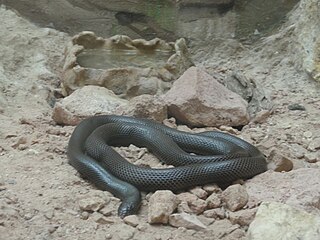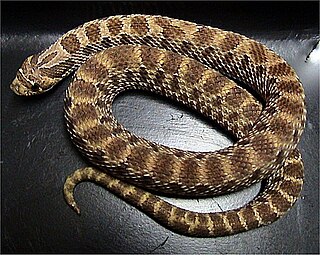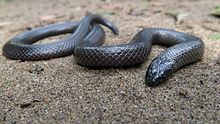
The Atractaspididae (atractaspidids) are a family of venomous snakes found in Africa and the Middle East, commonly called mole vipers, stiletto snakes, or burrowing asps. Currently, 12 genera are recognized.

The boomslang is a large, highly venomous snake in the family Colubridae.

Atractaspis is a genus of venomous snakes in the family Atractaspidae, also known as the stiletto snakes. The genus is endemic to Africa and the Middle East. The genus contains 15 species that are recognized by ITIS. Others recognize as many as 21 species. 23 are listed here.

Children's python is a species of nonvenomous snake in the family Pythonidae. The species is named after John George Children. It is a nocturnal species occurring in the northern half of Australia and generally found on the ground, although it often climbs trees. Usually growing to about 1.0 m (3 ft) in length or more depending on the polymorphic variant, it is typically a reddish-brown colour, darker on the upper surface, and with many darker blotches, especially on younger specimens. The Stimson's python variant has much stronger and more variable colors; often being adorned with reddish-brown to chocolate blotches against lighter tan. It feeds mostly on small mammals and birds, and as with other pythons, it constricts its prey before swallowing it whole. It is a popular pet among reptile enthusiasts.

The western hognose snake is a species of snake in the family Colubridae. The species is endemic to North America. There are three subspecies that are recognized as being valid, including the nominotypical subspecies.

The smooth earth snake is a species of nonvenomous natricine colubrid snake native to the eastern half of the United States.

Micrelaps is a genus of rear-fanged mildly venomous snakes. It is the only genus in the family Micrelapidae. The genus is native to Africa and the Middle East, and there are four species that are recognized as being valid.

Xenocalamus is a genus of rear-fanged mildly venomous snakes in the family Atractaspididae. The genus is endemic to Africa. Five species are recognized as being valid.

Hoplocephalus is a genus of venomous snakes in the family Elapidae. The genus is endemic to Australia. Three species are recognized.

Aparallactus is a genus of rear-fanged mildly venomous snakes found in Africa. Currently, 11 species are recognized.
Brachyophis is a monotypic genus created for the rear-fanged mildly venomous snake species, Brachyophis revoili, commonly known as Revoil's short snake, which is endemic to Eastern Africa. Three subspecies are recognized as being valid.

Elapotinus is a monotypic genus created for the rear-fanged snake species, Elapotinus picteti. The species is endemic to Madagascar. It is also known commonly as Jan's snake in honor of Italian herpetologist Giorgio Jan. There are no subspecies that are recognized as being valid.
Hypoptophis is a monotypic genus created for the rear-fanged (opisthoglyphous) mildly venomous snake species, Hypoptophis wilsonii. The species, which is endemic to Africa, is in the subfamily Aparallactinae of the family Atractaspididae. There are no subspecies that are recognized as being valid.

Polemon is a genus of rear-fanged mildly venomous snakes in the family Atractaspididae. The genus is endemic to Africa. Fifteen species are recognized as being valid.
The striped crayfish snake is a species of semiaquatic North American snake in the family Colubridae. The species derives its common name from its principal prey, crayfish. This snake is also called Allen's snake, the striped swamp snake, the striped swampsnake, or simply the swamp snake. It is endemic to peninsular Florida. Although rarely seen due to its secretive behavior, it can be found in large numbers in wet areas, with densities approaching 1,300 snakes per hectare.

Amblyodipsas unicolor, commonly known as the western glossy snake or the western purple-glossed snake, is a species of rear-fanged snake in the family Atractaspididae. It is one of the better known species in the genus Amblyodipsas.
Amblyodipsas dimidiata, or the Mpwapwa purple-glossed snake, is a species of mildly venomous rear-fanged snake in the Atractaspididae family.

Xenocalamus mechowii, or the elongate quill-snouted snake, is a species of mildly venomous rear-fanged snake in the subfamily Aparallactinae of the family Atractaspididae. The species is endemic to Africa.

Amblyodipsas microphthalma, also known as the eastern purple-glossed snake or white-lipped snake, is a species of mildly venomous rear-fanged snake in the Atractaspididae family.

The large-eyed green tree snake, also known commonly as the splendid dagger-tooth tree snake, is a species of venomous snake in the family Colubridae. The species is endemic to Africa. There are three recognized subspecies.















